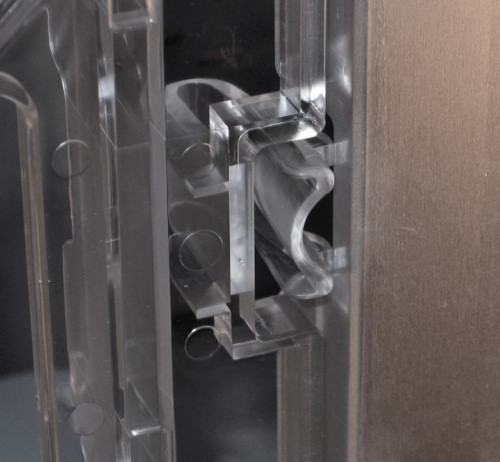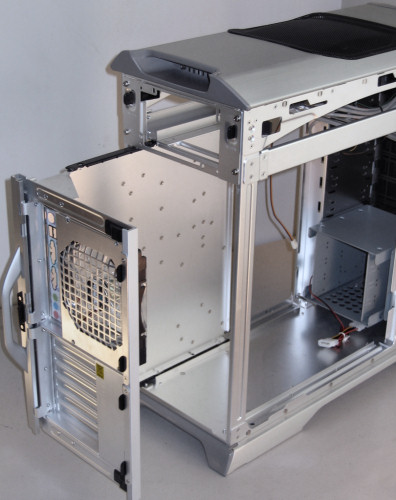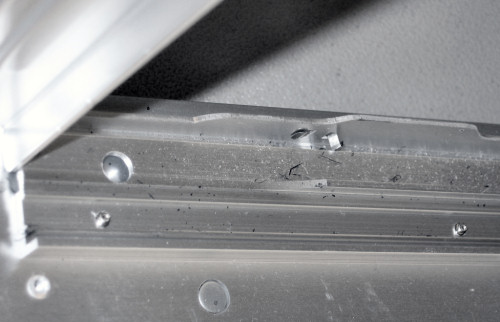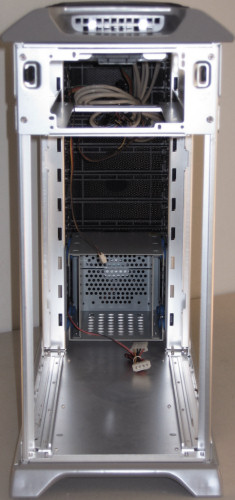Clash of the Titans - TT Tai Chi vs. CM Stacker 830
by Joshua Buss on February 23, 2006 12:05 AM EST- Posted in
- Cases/Cooling/PSUs
Cooler Master Stacker 830 (cont’d)
Cooler Master made the side fan cage's implementation nearly perfect, which really makes it one of the nicest aspects of the entire case.
Two clips, just like the one pictured above, hold the door shut at the front when it's in its hinges. They're simple, effective, and since they are built like small springs, they help to absorb any extra vibrations, which helps minimize noise.
At the back on the top and bottom, the door is suspended between two springs.
These spring-loaded stubs keep the door aligned perfectly for swinging, but release to make its entire removal easily possible. It really is a great feature and goes a long way to make the case a delight in which to work.
Along with the side panels and fan cage, the motherboard tray can be taken out as well, but unlike the Tai Chi, the Stacker's tray includes the rear and comes out the back. The black clips halfway down the left side and at the top and bottom on the right side in this picture are what lock the tray in place; once unlocked, the tray slides along plastic rails, which brings us to our next picture.
After only a few cycles of removing the tray and putting it back in, we noticed that plastic shavings were accumulating at the bottom of the case. While certainly it won't affect the case in any huge manner, it does mean that eventually the fit of the tray to the rest of the case might not be as snug as it is initially.
With the tray out, the 830 is amazingly open. In this shot from the rear, we can barely see the third and final included 120mm fan at the front of the hard drive cage. Also take note that there is almost perfect symmetry to the new Stacker – even the rails for the motherboard tray are on both sides. More on that to come.
Cooler Master made the side fan cage's implementation nearly perfect, which really makes it one of the nicest aspects of the entire case.
Two clips, just like the one pictured above, hold the door shut at the front when it's in its hinges. They're simple, effective, and since they are built like small springs, they help to absorb any extra vibrations, which helps minimize noise.
At the back on the top and bottom, the door is suspended between two springs.
These spring-loaded stubs keep the door aligned perfectly for swinging, but release to make its entire removal easily possible. It really is a great feature and goes a long way to make the case a delight in which to work.
Along with the side panels and fan cage, the motherboard tray can be taken out as well, but unlike the Tai Chi, the Stacker's tray includes the rear and comes out the back. The black clips halfway down the left side and at the top and bottom on the right side in this picture are what lock the tray in place; once unlocked, the tray slides along plastic rails, which brings us to our next picture.
After only a few cycles of removing the tray and putting it back in, we noticed that plastic shavings were accumulating at the bottom of the case. While certainly it won't affect the case in any huge manner, it does mean that eventually the fit of the tray to the rest of the case might not be as snug as it is initially.
With the tray out, the 830 is amazingly open. In this shot from the rear, we can barely see the third and final included 120mm fan at the front of the hard drive cage. Also take note that there is almost perfect symmetry to the new Stacker – even the rails for the motherboard tray are on both sides. More on that to come.















55 Comments
View All Comments
JoshuaBuss - Sunday, February 26, 2006 - link
The stacker 830 would probably be a perfect case for someone like you.. it has the potential for an incredible amount of air flow right at the hard drives and video cardstjr508 - Friday, February 24, 2006 - link
This article states the front bay pannes on the CM case are held in loosely. I find that strange being my $50 CM case (awsome case) actually uses screws to hold these in place, making them the most secure that I have ever seen. I wonder why CM felt it important to secure these tightly on their $50 cases but not on their $250 case?chynn - Thursday, March 2, 2006 - link
Wrong! What Anandtech did not do with the RC-830 was to lock the 4to3 drive bays down with the provided screws. The snap locks are there only to position the drive bays, and anything else, that fit into the 5.25in slots.Only the Lian-Li V1000 and V1200 cases, in my experience, have a fool-proof and moron-tolerant hard drive locking mechanism.
JoshuaBuss - Monday, May 15, 2006 - link
I was referring to the pop-out panels that cover unused 5 1/4" drive bays. They're very loose, and there's no screws for holding them in place.BikeDude - Friday, February 24, 2006 - link
I have been using the Armor case for almost a year, and the green plastic clips still gives me nightmares.If you get impatient, they'll simply detach and you'll have to nudge them back in again. In practice, I've wasted a lot of time nursing cards underneath the clips, reattaching the clips and finally pray it all fits in the end.
Even a simple old-school phillipshead screw would've saved me _a lot_ of time!
It is disheartening to see that TT not only makes mistakes, but insist on repeating them. :(
Also, the four holes for watercooling, on my Armor case atleast, are positioned too close. Atleast when attaching the Zalman Reserator-1 system. With the reserator you can choose to have a junction there so that you can more easily detach the cooler and move the case... Won't work if you have two Reserators...
Tamale - Friday, February 24, 2006 - link
Interesting point about the reserators.. what's the junction exactly?As for the green clips, I tend to agree.. it's a shame they didn't come up with a solution as elegant as the thumbscrews used to hold the 5 1/4" drives.. but for the majority of cards they do work very nicely.
theoak - Friday, February 24, 2006 - link
The reviewer calls this a tie.If keeping your components cool is the objective, I feel that the 830 wins by a landslide.
If you look neer the end of the review at the heat comparison chart, the 830 wins or ties all but two (HDD and System Exhaust).
The reviews gives the system exhaust win to the Tai Chi. I have to disagree. The fact that the components are cooler, implies to me that the system exhaust would therefore have to be hotter, because it is cooling the components better.
If you take the sum of the exhaust results you get:
Tai Chi 54.2/60.4
830 53.4/59.6
The combined values I feel demonstrate that the air temperature in the 830 is cooler and hence offers better airflow.
(I do not work for either of these companies nor do I own either of the boxes. My computer is a P3 650 :( )
Tamale - Friday, February 24, 2006 - link
You're absolutely right.. the 830 did a slightly better job of cooling than the Tai Chi did in our comparison.. BUT.. it was using FOUR 120mm fans to accomplish this as oppossed to the Tai Chi's two. The fans aren't rated that different in terms of CFM, so adding even a single fan to the side of the Tai Chi would undoubtedly bring its temperatures even closer to the stacker's.chynn - Thursday, March 2, 2006 - link
Anandtech got a "non-stock" RC-830 case. The "stock" RC-830 case I received contained two fans, not four.Besides, stock case fans are usually less than adequate. I would replace them with 120mm Scythe SFF21F fans because the Scythe have: high MTBF (150,000hrs), more volume (63+CFM), and lower noise (fluid bearing 28DBa). If that's too much noise, use a D or E model; less noise but less air too.
And no, I don't work for Scythe ... I'm opinionated is all ... :)
theoak - Friday, February 24, 2006 - link
Ahhh,I was unaware and/or missed that the 830 had more fans. That would tip the scales a little.
For what its worth ... I agree that it is a tie then :)